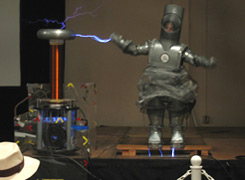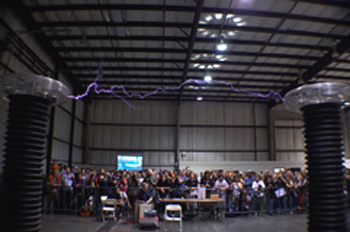Tesla in paradise
Even in the company of a two-story nose-picking machine, human cupcakes, battling robots, and power-tool drag races, the giant Tesla coil stands out.
Maybe it's the loud buzz and crackle of artificial lightning bolts, writhing like fiery serpents from the top of the thing.
 |
| Photo courtesy of Jason Chen, Gizmodo.com |
Maybe it's the hint of danger: More than one million volts! Stay back behind the ropes, and turn off your cell phone!
Paulina Shearer and her brother, Andrew, watched wide-eyed, hands over their ears, as a volunteer, safely enclosed in a clunky metal suit, came forward to do battle with the flashing electrical arcs (Look folks, he's safe! Give him a hand!).
"It was cool," six-year-old Paulina said, "but kind of freaky."
The scene was the second annual Maker Faire in San Mateo, California, put on in late May by the publishers of Make, a magazine devoted to do-it-yourself technology projects.
Terry Schalk and Hartmut Sadrozinski, adjunct professors of physics at the Santa Cruz Institute of Particle Physics, haul the Tesla coil to schools about 10 times a year, using it to lure kids into the world of science. Their demonstrations span everything from atoms and galaxies to how particle accelerators work.
 |
| Photo courtesy of Jason Chen, Gizmodo.com |
"This is just enough entertainment to catch the attention of students. It's enough real physics to actually present some meat," says Schalk, who works on experiments at the Stanford Linear Accelerator Center (SLAC). "We use it to tell them about opportunities, and also to let them see we're having fun, that there are jobs in the world where you get paid to do what you find interesting."
Despite the theatrics, he adds, the coil itself is not that dangerous: "I'd just as soon not get hit by it, but I wouldn't be afraid to get hit by it."
From Schalk's standpoint, the two-day stint at the Maker Faire was a big success. A lot of people came up after the demonstrations to sign up for SLAC tours, find out how to bring the Tesla coil to their school or ask about summer programs for their kids.
The Faire itself was icing on the cake—the perfect venue for a guy who, as an undergraduate, helped three friends build a working 1.5 MeV cyclotron from scratch.
"This whole show was a geek's paradise," Schalk says. "It was eye candy everywhere. I was drooling all over the LEGO train apparatus, and all over the 3D printers that make things out of sugar.
Glennda Chui
Click here to download the pdf version of this article.






